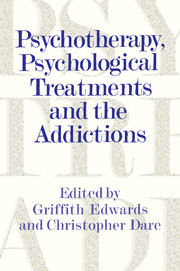Book contents
- Frontmatter
- Contents
- List of contributors
- Psychotherapy and psychological treatments of substance problems: generalism, specialism and the building of bridges
- Acknowledgements
- Part one Backgrounds to therapeutic understanding
- Part two Treatments
- 5 Psychotherapy: why do some need more and some need less?
- 6 Addictive behaviour: the next clinic appointment
- 7 Advances in families and couples therapy
- 8 Solution focused brief therapy: a co-operative approach to work with clients
- 9 Recent developments in cognitive and behavioural therapies
- 10 Cognitive and behavioural treatments for substance misuse
- 11 Motivational issues in the treatment of addictive behaviour
- 12 Can ‘stages of change’ provide guidance in the treatment of addictions? A critical examination of Prochaska and DiClemente's model
- 13 Group therapy and the addictions
- 14 Alcoholics Anonymous as mirror held up to nature
- 15 How therapeutic communities work
- Part three Postscript
- Index
7 - Advances in families and couples therapy
from Part two - Treatments
Published online by Cambridge University Press: 05 August 2016
- Frontmatter
- Contents
- List of contributors
- Psychotherapy and psychological treatments of substance problems: generalism, specialism and the building of bridges
- Acknowledgements
- Part one Backgrounds to therapeutic understanding
- Part two Treatments
- 5 Psychotherapy: why do some need more and some need less?
- 6 Addictive behaviour: the next clinic appointment
- 7 Advances in families and couples therapy
- 8 Solution focused brief therapy: a co-operative approach to work with clients
- 9 Recent developments in cognitive and behavioural therapies
- 10 Cognitive and behavioural treatments for substance misuse
- 11 Motivational issues in the treatment of addictive behaviour
- 12 Can ‘stages of change’ provide guidance in the treatment of addictions? A critical examination of Prochaska and DiClemente's model
- 13 Group therapy and the addictions
- 14 Alcoholics Anonymous as mirror held up to nature
- 15 How therapeutic communities work
- Part three Postscript
- Index
Summary
The development of systemic family therapy
The field of family and couple therapy has seen many changes over the past four decades. With its roots in family interaction research, systemic family therapy now blossoms in many different contexts, ranging from specialised clinics to psychiatric hospitals, schools, social services and commercial organisations. Whether the term ‘advances’, with its connotation of progress, is justified, is ultimately for the reader to decide. Some of the changes could be viewed as leaps forward, others perhaps more like two steps backward. And there are those old and familiar practices that are described in trendy terminology - which is about the only thing that is new about them.
Perhaps the most significant impetus for the development of family therapy came from a group of researchers and clinicians in Palo Alto, led by the anthropologist Gregory Bateson. They were particularly interested in studying the patterns of schizophrenic transaction. The group analysed schizophrenic communication and postulated that it was the family of the schizophrenic that had shaped their thought processes via the often bizarre communication requirements imposed on them (Bateson et al. 1956; Bateson, 1978). Bateson and his co-workers also observed that frequently, when the patient got better, someone else in the family appeared to get worse. At times it seemed that the family required a symptomatic person so that it could function better. In fact, the symptomatic person, or ‘identified patient’ appeared to get stuck in that role and it could then be noticed that everyone resisted change - even if that meant resisting or blocking the clinical improvement of the identified patient. Jackson (1957) termed this phenomenon ‘family homeostasis’ and viewed the family as a ‘system’ with equilibrium-maintaining properties, such as coalitions, covert conflicts and scapegoatism. Jackson and other members of Bateson's original group then widened their interests to a whole range of families, not just those containing a schizophrenic member (Watzlawick et ai, 1967), in an attempt to classify ‘typical’ communication and interaction patterns over this broad range of families. Interestingly, in Britain the work of Laing and Esterson (1971) initially also focused on the families of patients diagnosed as suffering from schizophrenia. They came up with similar findings to those of Bateson's early study group: they argued that confusing and mystified communication patterns inside the family led to the ill person's distorted perceptions.
- Type
- Chapter
- Information
- Psychotherapy, Psychological Treatments and the Addictions , pp. 110 - 123Publisher: Cambridge University PressPrint publication year: 1996



